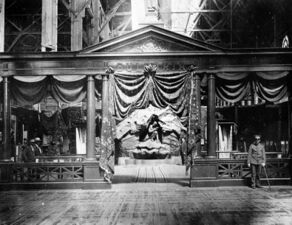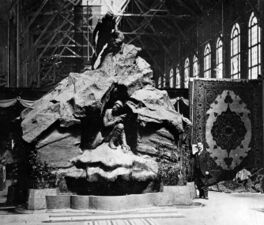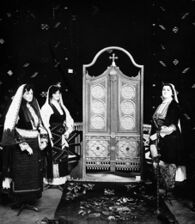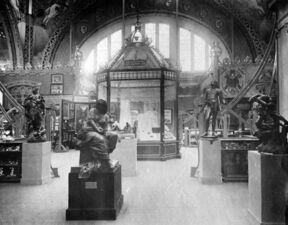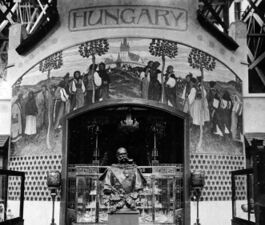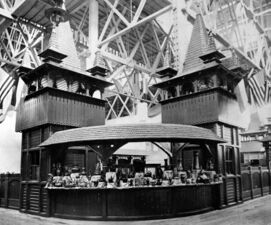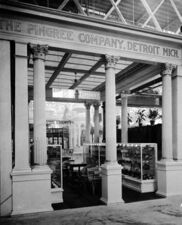Palace of Manufacturers: Difference between revisions
No edit summary |
No edit summary |
||
| (21 intermediate revisions by the same user not shown) | |||
| Line 1: | Line 1: | ||
{{ | {{SHORTDESC:Palace of Manufacturers}} | ||
{{Infobox | {{Infobox FairBuilding | ||
| name = Palace of Manufacturers | | name = Palace of Manufacturers | ||
| image = Palace of Manufacturers.jpg | | image = Palace of Manufacturers.jpg | ||
| image_size = | | image_alt = | ||
| image_size = 400px | |||
| caption = Palace of Manufacturers | | caption = Palace of Manufacturers | ||
| alternate_name = | | alternate_name = The Shopping Center of the Fair | ||
| | | location = [[Main Picture]] | ||
| | | no_buildings = 1 | ||
| | | construction_cost= $723,510 (${{Format price|{{Inflation|US|723,510|1904}}}} in {{Inflation/year|US}}) | ||
| furnishing_cost = | |||
| | |||
| profit = | | profit = | ||
| owner = | | owner = | ||
| | | architect = Carrere and Hastings of New York | ||
| | | dimensions = 1,200' x 525' | ||
| | | adult_entry = | ||
| child_entry = | |||
| opening_day = | |||
| dedication_day = | |||
| special_day = August 8th, 1904 | |||
| other = | | other = | ||
| floorplan_image = FP-Palace Manufacturers.jpg | |||
| ticket_image = | |||
}} | }} | ||
The '''Palace of Manufactures''' and her sister structure, the [[Palace of Varied Industries]] were two of the most striking and ornate buildings in the [[Main Picture]]. The palace mainly showcased items for the household and personal use, from the finest jewelry to early vacuum cleaners and radiators, to cutlery and clothing. | |||
The Palace of Manufactures and her sister structure, the [[Palace of Varied Industries]] were two of the most striking and ornate buildings in the [[Main Picture]]. | |||
==Before the Fair== | ==Before the Fair== | ||
The palace was going to be built with huge 400 foot towers at the center of the north facades, but they were | The palace was going to be built with huge 400 foot towers at the center of the north facades, but they were abandoned as being too impractical and expensive. | ||
==Description== | ==Description== | ||
Architecturally, the Corinthian order was generally employed throughout for the main columns. The north and south fronts had five lofty arcades on each side of the central entrances, the piers to the same being ornamented with coupled Corinthian columns. In front of each pair of columns was a, plinth projecting 15', holding a Greek Sphinx | |||
A cornice and paneled frieze was used in the entablature to the main columns, the former being continued all round the building. The space between the columns and the main wall formed an effective loggia, and the openings in the main wall were treated with coupled Ionic columns. | |||
The east and west fronts had the Corinthian columns standing free, and circular ornamentation and swags enriched the piers between the openings to the main wall behind them. The same treatment of sculpture upon projecting plinths was again employed in the interspace between every fourth and fifth column. | |||
The | The massive arched central entrances were very imposing, and the skillful introduction of the fountains, to the north and south fronts, as shown upon the plan at these points, was very effective. The simple domes over the corner entrances were finely detailed, and added very much to the general effect. | ||
The whole building was raised upon a stylobate of steps, while the semicircular Mansard roof, with its well-modelled finials and ornaments, greatly assisted the skyline. | |||
A large portion of the internal circular court was occupied by a French exhibit. | |||
On Manufactures Day, every visitor to the palace was given a ticket for a free drawing. There was a choice of five prizes for the winner: a silver dinner service, marble statue, a Japanese cabinet, a Porcelain statue, or a tea table service set, each valued at $500 (${{Format price|{{Inflation|US|500|1904}}}} today). However, the winner of the Manufactures Day ticket never claimed their prize. | |||
All in all, $25,000 ({{Inflation|US| | All in all, $25,000 (${{Format price|{{Inflation|US|25000|1904}}}} today) of prizes were given out throughout Manufacturers Day. | ||
The last month of the Fair resulted in many of the palaces' goods being reduced in price. Postcards cost 5 for a penny, while watch fobs cost 15 cents. | The last month of the Fair resulted in many of the palaces' goods being reduced in price. Postcards cost 5 for a penny, while watch fobs cost 15 cents. | ||
==Notable Exhibits== | ==Notable Exhibits== | ||
Over 900 industries could be seen in this Palace alone. Retailers could rent small six-foot square booths in an area called ''the bazaars'' or ''arcades'', to showcase and pedal their wares efficiently. There were a few sections of these bazaars throughout the palace. | |||
===Companies=== | Some of the exhibits that were crowded out of the Varied Industries building were house in the Palace of Manufactures. The western half of the palace contained hardware while the eastern contained textiles. | ||
===Refreshments=== | |||
The Welch's Grape, and the Chautauqua Juice Companies provided fresh juice to the thirsty fairgoers. Many other concessionaires and companies provided food and snacks as well. | |||
===M.D. Knowlton Company=== | |||
This Rochester New York company exhibited a cardboard box making plant. Boxes were sold to the exhibitors to use in packaging their sold wares. | |||
===Brown Shoe Company=== | |||
The St. Louis company exhibited a working display of manufacturing shoes. 300 pairs of shoes were made daily. During the Fair, a young Brown Shoe executive met Buster Brown's creator, cartoonist Richard F. Outcault, and purchased the name from him. At the time, Buster Brown was a mischievous cartoon character, who, together with his dog Tige and sister Mary Jane, delighted children of all ages. The Brown Shoe Company was named after founder George Warren Brown, not Buster. | |||
===Singer Sewing Machine Company=== | |||
As with the [[Palace of Varied Industries]], Singer had a two-story display in the Palace of Manufactures. Lady sewing operators produced corsets and other clothing that could be purchased on site. | |||
===Elk Manufacturing and Vending Company=== | |||
Displayed many Cigar Vending machines spread around the palace. | |||
===Majestic Manufacturing Company=== | |||
This display showcased their new Majestic stoves. The company's display looked like a a front half of a ship docked to a wharf warehouse. | |||
===Simmon's Hardware Company=== | |||
Simmon's Hardware Company showed off a dazzling display of knives and hardware incredibly arranged into ornate displays. Part of the exhibit resembled a windmill fabricated from Keen Kutter tools. The windmill 'blades,' were constructed from 5,000 axes. The exhibit also included an 11 foot long extended pocket knife and seven foot long sheers, made by Keen Kutter. This display won a gold medal for artistry of design. | |||
===Italy=== | |||
At the western entrance, Italy had an exhibit of 5,000 marble and alabaster sculptures, installed not by artists, but by great Italian firms dealing in such works - marble and bronze copies of famous old masterpieces of sculpture, with many original pictures and groups by scores of modern Italian sculptors. Italy also showcased Florentine and Venetian vases as well as fine thread. | |||
===Hungary=== | |||
The greater part of the Hungarian exhibits in this section were displayed in a model house of size rooms, the furnishings of which illustrated modern Hungarian manufacture and decorative art. | |||
Zsolmay, had a fine exhibit of Majolica<ref group="Note">Majolica is a beautiful ware prepared by tin-glazing earthenware and firing it a second time. It originated in 9th century in the Middle East.</ref> from their potteries at Pécs, Hungary. | |||
The wrought iron gate to the Hungarian booth was entirely hand hammered. The exhibits here covered a wide range in fourteen groups of arts and crafts, hand-wrought metals, jewelry, artistic needle-work, embroideries, carpets, tapestries and art furniture. | |||
===Denmark=== | |||
Traditional Royal Copenhagen porcelain | |||
===Austria=== | |||
A large display of watches, cut glass, silverware and clocks. | |||
===France=== | |||
=== | |||
[[File:Manufacturers - France Dress.jpg|200px|thumb|right|Gowns in the French Exhibit]] | |||
An eloquent showcase of gowns, dresses and fur. Live models were used to great effect. On 22 Aug 1904, a massive rainstorm cased the glass dome above the French exhibit to leak, destroying many gowns in the exhibit below. <ref>"$200,000 Gowns Ruined",'''Savannah Morning News''' | |||
23 Aug 1904, pg. 7</ref> | |||
== | Mr. Atanik Eknayan, of Paris, France, the largest cutter and dealer in diamonds and precious stones in the world, showed his collection of perfect diamonds, including a single stone valued at $100,000 (${{Format price|{{Inflation|US|100000|1904}}}} today). Unusually interesting was the display of colored diamonds, which included red, pink, canary, golden brown, green brown, blue, white, brown, steel green, golden yellow, reddish brown and jet black diamonds. | ||
=== Mexico === | |||
Mexico had $250 (${{Format price|{{Inflation|US|250|1904}}}} today) sombreros for sale as well as gifts made out of onyx. | |||
==Gallery== | |||
<gallery |="" class="center" mode="packed-hover" widths="150px" heights="150px">> | |||
File:Manufacturers - Bulgarian.jpg | Belgium Display | |||
File:Manufacturers - Bulgarian Entrance.jpg| Belgium Entrance | |||
File:Manufacturers - Bulgarian Costumes.jpg | Belgium Costumes | |||
File:Manufacturers - France.jpg | French Exhibit | |||
File:Manufacturers - Hungary.jpg | Hungary Entance | |||
File:Manufacturers - Hungary Exhibit.jpg | Hungary Echibit | |||
File:Manufacturers - American Art Marble.jpg |American Art Marble | |||
File:Manufacturers - Gorham Jewlers.jpg | Gorham Jewelers | |||
File:Manufacturers - Pingree.jpg | Pingree Company | |||
File:Manufacturers - Rice & Hutchins.jpg | Rice & Hutchins | |||
</gallery> | |||
==See also== | ==See also== | ||
==Notes== | ==Notes== | ||
<references group="Note" /> | |||
==References== | ==References== | ||
<references/> | |||
==External links== | ==External links== | ||
[[Category:Main Picture]] | [[Category:Main Picture]] | ||
Latest revision as of 03:56, 9 December 2022
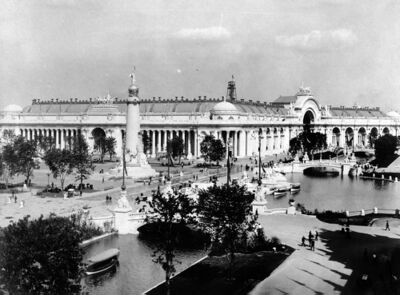 | |
| Alternative names | The Shopping Center of the Fair |
|---|---|
| Location | Main Picture |
| No. of Buildings | 1 |
| Construction | |
| Construction Cost | $723,510 ($21.8 million in 2021) |
| Dates | |
| Special Day | August 8th, 1904 |
| Architecture | |
| Architect | Carrere and Hastings of New York |
| Dimensions | 1,200' x 525' |
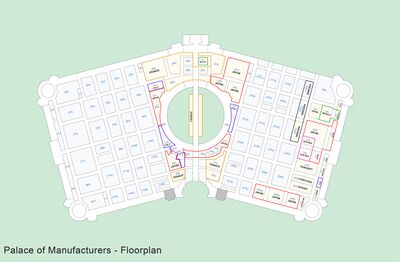 | |
The Palace of Manufactures and her sister structure, the Palace of Varied Industries were two of the most striking and ornate buildings in the Main Picture. The palace mainly showcased items for the household and personal use, from the finest jewelry to early vacuum cleaners and radiators, to cutlery and clothing.
Before the Fair[edit | edit source]
The palace was going to be built with huge 400 foot towers at the center of the north facades, but they were abandoned as being too impractical and expensive.
Description[edit | edit source]
Architecturally, the Corinthian order was generally employed throughout for the main columns. The north and south fronts had five lofty arcades on each side of the central entrances, the piers to the same being ornamented with coupled Corinthian columns. In front of each pair of columns was a, plinth projecting 15', holding a Greek Sphinx
A cornice and paneled frieze was used in the entablature to the main columns, the former being continued all round the building. The space between the columns and the main wall formed an effective loggia, and the openings in the main wall were treated with coupled Ionic columns.
The east and west fronts had the Corinthian columns standing free, and circular ornamentation and swags enriched the piers between the openings to the main wall behind them. The same treatment of sculpture upon projecting plinths was again employed in the interspace between every fourth and fifth column.
The massive arched central entrances were very imposing, and the skillful introduction of the fountains, to the north and south fronts, as shown upon the plan at these points, was very effective. The simple domes over the corner entrances were finely detailed, and added very much to the general effect.
The whole building was raised upon a stylobate of steps, while the semicircular Mansard roof, with its well-modelled finials and ornaments, greatly assisted the skyline.
A large portion of the internal circular court was occupied by a French exhibit.
On Manufactures Day, every visitor to the palace was given a ticket for a free drawing. There was a choice of five prizes for the winner: a silver dinner service, marble statue, a Japanese cabinet, a Porcelain statue, or a tea table service set, each valued at $500 ($15,080 today). However, the winner of the Manufactures Day ticket never claimed their prize.
All in all, $25,000 ($753,981 today) of prizes were given out throughout Manufacturers Day.
The last month of the Fair resulted in many of the palaces' goods being reduced in price. Postcards cost 5 for a penny, while watch fobs cost 15 cents.
Notable Exhibits[edit | edit source]
Over 900 industries could be seen in this Palace alone. Retailers could rent small six-foot square booths in an area called the bazaars or arcades, to showcase and pedal their wares efficiently. There were a few sections of these bazaars throughout the palace.
Some of the exhibits that were crowded out of the Varied Industries building were house in the Palace of Manufactures. The western half of the palace contained hardware while the eastern contained textiles.
Refreshments[edit | edit source]
The Welch's Grape, and the Chautauqua Juice Companies provided fresh juice to the thirsty fairgoers. Many other concessionaires and companies provided food and snacks as well.
M.D. Knowlton Company[edit | edit source]
This Rochester New York company exhibited a cardboard box making plant. Boxes were sold to the exhibitors to use in packaging their sold wares.
Brown Shoe Company[edit | edit source]
The St. Louis company exhibited a working display of manufacturing shoes. 300 pairs of shoes were made daily. During the Fair, a young Brown Shoe executive met Buster Brown's creator, cartoonist Richard F. Outcault, and purchased the name from him. At the time, Buster Brown was a mischievous cartoon character, who, together with his dog Tige and sister Mary Jane, delighted children of all ages. The Brown Shoe Company was named after founder George Warren Brown, not Buster.
Singer Sewing Machine Company[edit | edit source]
As with the Palace of Varied Industries, Singer had a two-story display in the Palace of Manufactures. Lady sewing operators produced corsets and other clothing that could be purchased on site.
Elk Manufacturing and Vending Company[edit | edit source]
Displayed many Cigar Vending machines spread around the palace.
Majestic Manufacturing Company[edit | edit source]
This display showcased their new Majestic stoves. The company's display looked like a a front half of a ship docked to a wharf warehouse.
Simmon's Hardware Company[edit | edit source]
Simmon's Hardware Company showed off a dazzling display of knives and hardware incredibly arranged into ornate displays. Part of the exhibit resembled a windmill fabricated from Keen Kutter tools. The windmill 'blades,' were constructed from 5,000 axes. The exhibit also included an 11 foot long extended pocket knife and seven foot long sheers, made by Keen Kutter. This display won a gold medal for artistry of design.
Italy[edit | edit source]
At the western entrance, Italy had an exhibit of 5,000 marble and alabaster sculptures, installed not by artists, but by great Italian firms dealing in such works - marble and bronze copies of famous old masterpieces of sculpture, with many original pictures and groups by scores of modern Italian sculptors. Italy also showcased Florentine and Venetian vases as well as fine thread.
Hungary[edit | edit source]
The greater part of the Hungarian exhibits in this section were displayed in a model house of size rooms, the furnishings of which illustrated modern Hungarian manufacture and decorative art.
Zsolmay, had a fine exhibit of Majolica[Note 1] from their potteries at Pécs, Hungary. The wrought iron gate to the Hungarian booth was entirely hand hammered. The exhibits here covered a wide range in fourteen groups of arts and crafts, hand-wrought metals, jewelry, artistic needle-work, embroideries, carpets, tapestries and art furniture.
Denmark[edit | edit source]
Traditional Royal Copenhagen porcelain
Austria[edit | edit source]
A large display of watches, cut glass, silverware and clocks.
France[edit | edit source]
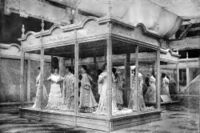
An eloquent showcase of gowns, dresses and fur. Live models were used to great effect. On 22 Aug 1904, a massive rainstorm cased the glass dome above the French exhibit to leak, destroying many gowns in the exhibit below. [1]
Mr. Atanik Eknayan, of Paris, France, the largest cutter and dealer in diamonds and precious stones in the world, showed his collection of perfect diamonds, including a single stone valued at $100,000 ($3.02 million today). Unusually interesting was the display of colored diamonds, which included red, pink, canary, golden brown, green brown, blue, white, brown, steel green, golden yellow, reddish brown and jet black diamonds.
Mexico[edit | edit source]
Mexico had $250 ($7,540 today) sombreros for sale as well as gifts made out of onyx.
Gallery[edit | edit source]
-
Belgium Display
-
Belgium Entrance
-
Belgium Costumes
-
French Exhibit
-
Hungary Entance
-
Hungary Echibit
-
American Art Marble
-
Gorham Jewelers
-
Pingree Company
-
Rice & Hutchins
See also[edit | edit source]
Notes[edit | edit source]
- ↑ Majolica is a beautiful ware prepared by tin-glazing earthenware and firing it a second time. It originated in 9th century in the Middle East.
References[edit | edit source]
- ↑ "$200,000 Gowns Ruined",Savannah Morning News 23 Aug 1904, pg. 7
